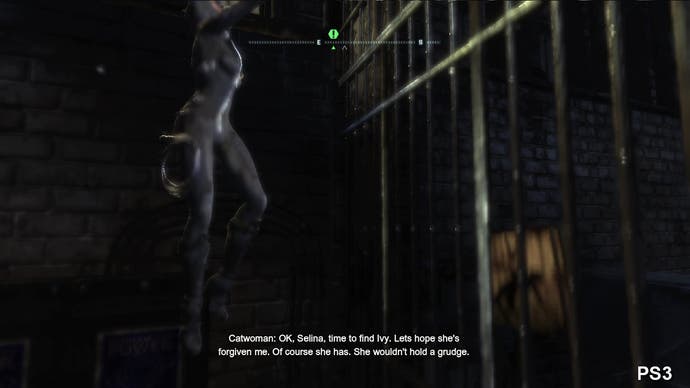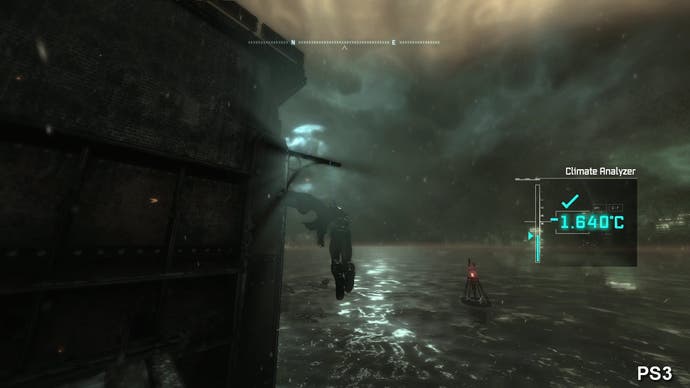Face-Off: Batman: Arkham City
Dark Knight in shining armour.
The big question is whether the small changes made to the rendering set-up have benefitted the overall level of performance. The key target here is to maintain the perceptual 'locked' 30FPS experience of Arkham Asylum while keeping screen tearing to a bare minimum.
Let's kick off by taking a look at an analysis video of the gameplay on offer in Arkham City. Below we've put together a number of clips showcasing different aspects featured during a general run of play, from traversal across the open-world city to close quarters combat. In short, we've tried to stress the engine in as many different gameplay scenarios as possible.
As with most UE3 titles, frame-rate is capped at 30FPS and v-sync is dropped when the engine goes over budget in rendering the current frame. The framebuffer is 'flipped' while the screen is refreshing, resulting in a torn frame. During combat you might come across one or two dropped or torn frames, but the experience is smooth and image consistency is left unharmed. However, the takedown sequences can show a bigger difference where the PS3 is concerned - lots of tearing is thrown into the mix and the frame-rate also takes a hit for a few seconds. It's clearly noticeable, but across the majority of combat scenes, the impression you get is that both versions are fairly solid.
The situation changes when Batman is traversing the vast hub world of Arkham City - the combination of plentiful detail and long draw distances clearly has a greater impact on performance. In stressful like-for-like situations, the PS3 version does tend to come off worse, with more pronounced frame-rate drops and more tearing, but any detrimental impact on gameplay is negligible. Batman: Arkham City doesn't demand low latency precision in its controls when performing combat moves and context sensitive actions, and in combination with the brevity of the dips in performance, it's mostly a non-issue.
Analysis of cut-scenes in the game gives us an opportunity to see how Unreal Engine 3 fares on both platforms when rendering almost identical sequences. Here we see a commonality with the results found in our gameplay analysis: sequences that showcase the long draw distances on offer come with a brief performance hit on both platforms, while the use of alpha-based effects tends to impact on the PS3 release more noticeably. The second clip showing off the scale of the environment reveals how frame-rates can drop to the mid-twenties when the engine is under a lot of stress, while the first and third clips featuring Batman and Harley Quinn are much smoother.
Overall, the 360 version is indeed the slightly better performer of the two releases - par for the course when it comes to Unreal Engine 3. However, in general gameplay terms the differences count for little: Batman: Arkham City doesn't really rely upon quick, high precision reactions during gameplay - there's a fair amount of leeway in terms of timing when performing moves and context-sensitive actions.
The fact that Rocksteady has managed to improve the visual look of the game so much compared to Arkham Asylum, and actually reduce the amount of screen-tear in many situations is quite remarkable. Perhaps the most dramatic improvement in the look of the game comes from enhancements made to the lighting model and the implementation of recent VFX additions to the Unreal Engine 3 SDK.
In Arkham City, we see the introduction of lightshafts on both platforms, adding an extra layer of depth and fidelity to the lighting. There's even a sense that this also enhances scenes set indoors: for example, lightshafts beam through windows from outside, while dynamic lightmaps work to create an ambience to the environments as Batman moves in and out of the shadows and surrounding light sources.




There are also a few differences with the game's lighting component on both platforms. For example, bloom appears stronger in nature on 360 (perhaps appearing a touch overblown) while in other scenes light sources appear less prominent on the PS3 - again, this is nothing new for Unreal Engine 3. However, a lighting off-set bias is also present, which means that some scenes are more aggressively bathed by shadow on the PS3. Shadow resolution and filtering however, are identical. In cut-scenes, shadows can appear a bit jagged on the characters on the Sony platform, but this is most likely down to the off-set bias interfering with how they intersect with each other at various points.
Elsewhere, the motion blur effect used sparingly in Arkham Asylum makes its return, although we now see character specific blur being applied during the performance of certain moves and in some of the short 'event' based sequences. It's very subtle and barely apparent in motion. We're guessing that it has been applied in such a way as not do distract during gameplay, but to add a mild cinematic feel to things in other areas. There has also been talk of character blur being applied during regular combat, although looking over the footage in slow motion we saw no traces of it.







